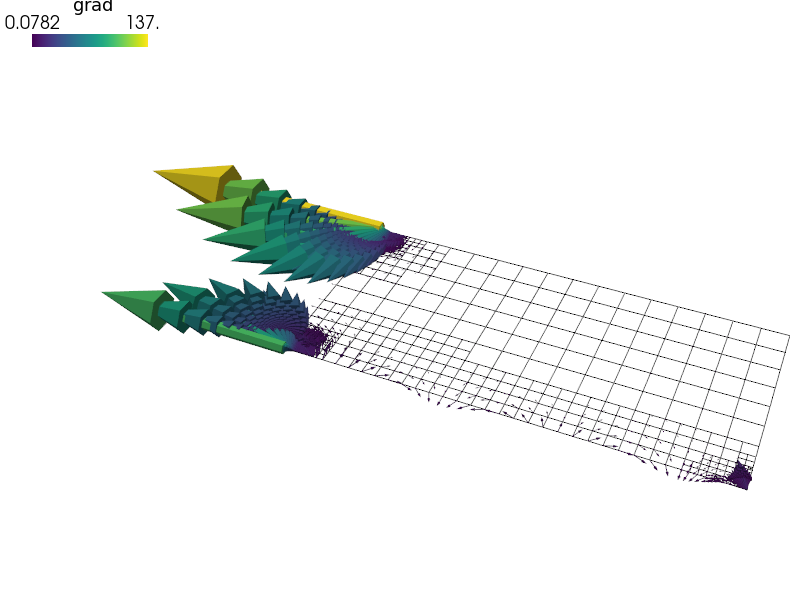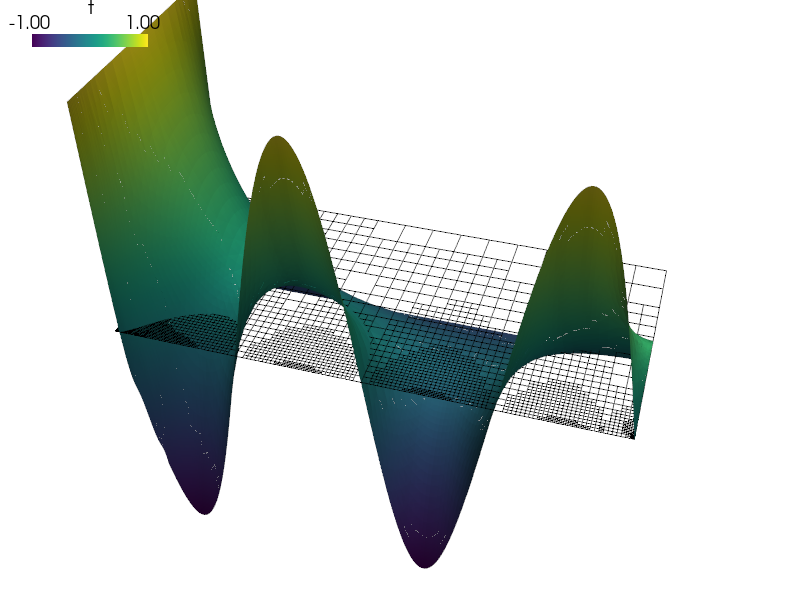diffusion/sinbc.py¶
Description
Laplace equation with Dirichlet boundary conditions given by a sine function and constants.
Find  such that:
such that:

This example demonstrates how to use a hierarchical basis approximation - it
uses the fifth order Lobatto polynomial space for the solution. The adaptive
linearization is applied in order to save viewable results, see both the
options keyword and the post_process() function that computes the solution
gradient. Use the following commands to view the results (assuming default
output directory and names):
$ ./postproc.py -b -d't,plot_warp_scalar,rel_scaling=1' 2_4_2_refined_t.vtk --wireframe
$ ./postproc.py -b 2_4_2_refined_grad.vtk
The sfepy.discrete.fem.meshio.UserMeshIO class is used to refine the original
two-element mesh before the actual solution.


r"""
Laplace equation with Dirichlet boundary conditions given by a sine function
and constants.
Find :math:`t` such that:
.. math::
\int_{\Omega} c \nabla s \cdot \nabla t
= 0
\;, \quad \forall s \;.
This example demonstrates how to use a hierarchical basis approximation - it
uses the fifth order Lobatto polynomial space for the solution. The adaptive
linearization is applied in order to save viewable results, see both the
options keyword and the ``post_process()`` function that computes the solution
gradient. Use the following commands to view the results (assuming default
output directory and names)::
$ ./postproc.py -b -d't,plot_warp_scalar,rel_scaling=1' 2_4_2_refined_t.vtk --wireframe
$ ./postproc.py -b 2_4_2_refined_grad.vtk
The :class:`sfepy.discrete.fem.meshio.UserMeshIO` class is used to refine the original
two-element mesh before the actual solution.
"""
from __future__ import absolute_import
import numpy as nm
from sfepy import data_dir
from sfepy.base.base import output
from sfepy.discrete.fem import Mesh, FEDomain
from sfepy.discrete.fem.meshio import UserMeshIO, MeshIO
from sfepy.homogenization.utils import define_box_regions
from six.moves import range
base_mesh = data_dir + '/meshes/elements/2_4_2.mesh'
def mesh_hook(mesh, mode):
"""
Load and refine a mesh here.
"""
if mode == 'read':
mesh = Mesh.from_file(base_mesh)
domain = FEDomain(mesh.name, mesh)
for ii in range(3):
output('refine %d...' % ii)
domain = domain.refine()
output('... %d nodes %d elements'
% (domain.shape.n_nod, domain.shape.n_el))
domain.mesh.name = '2_4_2_refined'
return domain.mesh
elif mode == 'write':
pass
def post_process(out, pb, state, extend=False):
"""
Calculate gradient of the solution.
"""
from sfepy.discrete.fem.fields_base import create_expression_output
aux = create_expression_output('ev_grad.ie.Elements( t )',
'grad', 'temperature',
pb.fields, pb.get_materials(),
pb.get_variables(), functions=pb.functions,
mode='qp', verbose=False,
min_level=0, max_level=5, eps=1e-3)
out.update(aux)
return out
filename_mesh = UserMeshIO(mesh_hook)
# Get the mesh bounding box.
io = MeshIO.any_from_filename(base_mesh)
bbox, dim = io.read_bounding_box(ret_dim=True)
options = {
'nls' : 'newton',
'ls' : 'ls',
'post_process_hook' : 'post_process',
'linearization' : {
'kind' : 'adaptive',
'min_level' : 0, # Min. refinement level to achieve everywhere.
'max_level' : 5, # Max. refinement level.
'eps' : 1e-3, # Relative error tolerance.
},
}
materials = {
'coef' : ({'val' : 1.0},),
}
regions = {
'Omega' : 'all',
}
regions.update(define_box_regions(dim, bbox[0], bbox[1], 1e-5))
fields = {
'temperature' : ('real', 1, 'Omega', 5, 'H1', 'lobatto'),
# Compare with the Lagrange basis.
## 'temperature' : ('real', 1, 'Omega', 5, 'H1', 'lagrange'),
}
variables = {
't' : ('unknown field', 'temperature', 0),
's' : ('test field', 'temperature', 't'),
}
amplitude = 1.0
def ebc_sin(ts, coor, **kwargs):
x0 = 0.5 * (coor[:, 1].min() + coor[:, 1].max())
val = amplitude * nm.sin( (coor[:, 1] - x0) * 2. * nm.pi )
return val
ebcs = {
't1' : ('Left', {'t.0' : 'ebc_sin'}),
't2' : ('Right', {'t.0' : -0.5}),
't3' : ('Top', {'t.0' : 1.0}),
}
functions = {
'ebc_sin' : (ebc_sin,),
}
equations = {
'Temperature' : """dw_laplace.10.Omega( coef.val, s, t ) = 0"""
}
solvers = {
'ls' : ('ls.scipy_direct', {}),
'newton' : ('nls.newton', {
'i_max' : 1,
'eps_a' : 1e-10,
}),
}

